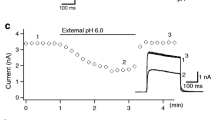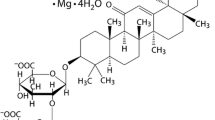Abstract
Reactive oxygen species have been implicated in different types of cardiac arrhythmias including human atrial fibrillation. Kv1.5, the presumed molecular correlate of IKur, is an important determinant of human atrial repolarization. The aim of this study was to assess the effects of H2O2, at pathophysiologically relevant concentrations (20–1,000 μM), on Kv1.5 expressed in Chinese hamster ovary cell line. Kv1.5 cDNA in pcDNA3 expression vector and CD8, a surface marker protein, were cotransfected in cells by calcium phosphate precipitation. Kv1.5 activation kinetics were significantly accelerated while the activation curve was negatively shifted by 10 mV (V1/2 changed from −9.3 to −19.0 mV) in the presence of 100 μM H2O2. The shift in Kv1.5 peak current I-V curve was voltage-dependent, the current amplitude being increased for voltages <+20 mV but decreased for high depolarizing voltages. The rapid activation time constant obtained from a bi-exponential fitting was decreased from 16.1±3.4 ms to 8.8±1.5 ms for a −20 mV depolarization (n=9; P=0.01) and from 4.3±2.1 ms to 2.3±0.4 ms when cells were depolarized to +20 mV (P<0.05). Kv1.5 steady-state inactivation was not modified by H2O2. Intracellular application of SOD or catalase reduced the H2O2 induced shift of activation I-V curve and SOD significantly decreased Kv1.5 amplitude at +40 mV (n=9; P<0.05). In conclusion, H2O2 increased Kv1.5 current amplitude at voltages corresponding to the action potential repolarization phase and accelerated Kv1.5 channel opening. These changes can reduce the action potential duration, leading to a shortening of the atrial effective refractory period. H2O2-induced changes in Kv1.5 properties could thus be involved in initiation or perpetuation of AF.






Similar content being viewed by others
References
Archer SL, London B, Hampl V, Wu X, Nsair A, Puttagunta L, Hashimoto K, Waite RE (2001) Impairment of hypoxic pulmonary vasoconstriction in mice lacking the voltage-gated potassium channel Kv1.5. FASEB J 15:1801–1803
Barrington PL, Meier CF Jr, Weglicki WB (1988) Abnormal electrical activity induced by free radical generating systems in isolated cardiocytes. J Mol Cell Cardiol 20:1163–1178
Bäumer AT, Flesch M, Wang X, Shen Q, Feuerstein GZ, Böhm M (2000) Antioxidative enzymes in human hearts with idiopathic dilated cardiomyopathy. J Mol Cell Cardiol 32:121–130
Becker LB, Hoek TLV, Shao Z-H, Li C-Q, Schumacker PT (1999) Generation of superoxide in cardiomyocytes during ischemia before reperfusion. Am J Physiol 277:H2240–H2246
Beckman KB, Ames BM (1998) The free radical theory of aging matures. Physiol Rev 78:547–581
Bérubé J, Chahine M, Daleau P (1999) Modulation of HERG potassium channel properties by external pH. Pflügers Arch 438:419–422
Bérubé J, Caouette D, Daleau P (2001) Hydrogen peroxide modifies the kinetics of HERG channel expressed in a mammalian cell line. J Pharmacol Exp Ther 297:96–102
Bolli R, Patei BS, Jeroudi MO, Lai EK, McCay PB (1988) Demonstration of free radical generation in “stunned” myocardium of intact dogs with the use of the spin trap α-phenyl N-tert-butyl nitrone. J Clin Invest 82:476–485
Caouette D, Bérubé J, Daleau P (2002) Hydrogen peroxide modulates Kv1.5 thought to underlie the cardiac atrial potassium channel IKur [abstract]. J Am Coll Cardiol 39:90B
Carnes CA, Chung MK, Nakayama T, Nakayama H, Baliga RS, Piao S, Kanderian A, Pavia S, Hamlin RL, McCarthy PM, Bauer JA, Van Wagoner DR (2001) Ascorbate attenuates atrial pacing-induced peroxynitrite formation and electrical remodeling and decreases the incidence of postoperative atrial fibrillation. Circ Res 89:e32–e38
Cavarocchi NC, England MD, Schaff HV, Russo P, Orszulak TA, Schnell WA Jr, O’Brien JF, Pluth JR (1986) Oxygen free radical generation during cardiopulmonary bypass: correlation with complement activation. Circulation 74:130–133
De Miera EVS, Rudy B (1992) Modulation of K+ channels by hydrogen peroxide. Biochem Biophys Res Commun 186:1681–1687
Drummond GR, Cai H, Davis ME, Ramasamy S, Harrison DG (2000) Transcriptional and posttranscriptional regulation of endothelial nitric oxide synthase expression by hydrogen peroxide. Circ Res 86:347–354
Duprat F, Guillemare E, Romey G, Fink M, Lesage F, Lazdunski M, Honoré E (1995) Susceptibility of cloned K+ channels to reactive oxygen species. Proc Natl Acad Sci USA 92:11796–11800
Feinberg WM, Blackshear JL, Laupacis A, Kronmal R, Hart RG (1995) Prevalence, age distribution, and gender of patients with atrial fibrillation. Arch Intern Med 155:469–473
Feng J, Wible B, Li G-R, Wang Z, Nattel S (1997) Antisense oligodeoxynucleotides directed against Kv1.5 mRNA specifically inhibit ultrarapid delayed rectifier K+ current in cultured adult human atrial myocytes. Circ Res 80:572–579
Feng J, Xu D, Wang Z, Nattel S (1998) Ultrarapid delayed rectifier current inactivation in human atrial myocytes: properties and consequences. Am J Physiol 275:H1717–H1725
Garlick PB, Davies MJ, Hearse DJ, Slater TF (1987) Direct detection of free radicals in the reperfused rat heart using electron spin resonance spectroscopy. Circ Res 61:757–760
Goldhaber JI, Weiss JN (1992) Oxygen free radicals and cardiac reperfusion abnormalities. Hypertension 20:118–127
Ide T, Tsutsui H, Kinugawa S, Suematsu N, Hayashidani S, Ichikawa K, Utsumi H, Machida Y, Egashira K, Takeshita A (2000) Direct evidence for increased hydroxyl radicals originating from superoxide in the failing myocardium. Circ Res 86:152–157
Kerr PM, Clément-Chomienne O, Thorneloe KS, Chen TT, Ishii K, Sontag DP, Walsch MP, Cole WC (2001) Heteromultimeric Kv1.2-Kv1.5 channels underlie 4-aminopyridine-sensitive delayed rectifier K+ current of rabbit vascular myocytes. Circ Res 89:1038–1044
Kuzuya T, Hoshida S, Kim Y, Nishida M, Fuji H, Kitabatake A, Tada M, Kamada T (1990) Detection of oxygen-derived free radical generation in the canine postischemic heart during late phase of reperfusion. Circ Res 66:1160–1165
Mason HS, Latten MJ, Godoy LD, Horowitz B, Kenyon JL (2002) Modulation of Kv1.5 currents by protein kinase A, tyrosine kinase, and protein tyrosine phosphatase requires an intact cytoskeleton. Mol Pharmacol 61:285–293
Matsuura H, Shattock MJ (1991) Effects of oxidant stress on steady-state background currents in isolated ventricular myocytes. Am J Physiol 261:H358–H365
Mays DJ, Foose JM, Philipson LH, Tamkun MM (1995) Localization of the Kv1.5 K+ channel protein in explanted cardiac tissue. J Clin Invest 96:282–292
Mihm MJ, Yu F, Carnes CA, Reiser PJ, McCarthy PM, Van Wagoner DR, Bauer JA (2001) Impaired myofibrillar energetics and oxidative injury during human atrial fibrillation. Circulation 104:174–180
Park MK, Bae YM, Lee SH, Ho W-K, Earm YE (1997) Modulation of voltage-dependent K+ channel by redox potential in pulmonary and ear arterial smooth muscle cells of the rabbit. Pflügers Arch 434:764–771
Persad S, Rupp H, Jindal R, Arneja J, Dhalla NS (1998) Modification of cardiac β-adrenoceptor mechanisms by H2O2. Am J Physiol 274:H416–H423
Roden DM, George AL Jr (1997) Structure and function of cardiac sodium and potassium channels. Am J Physiol 273:H511–H525
Sia YT, Lapointe N, Parker TG, Tsoporis JN, Deschepper CF, Calderone A, Pourdjabbar A, Jasmin JF, Sarrazin JF, Liu P, Adam A, Butany J, Rouleau JL (2002) Beneficial effects of long-term use of the antioxidant probucol in heart failure in the rat. Circulation 105:2549–2555
Snyders DJ, Tamkun MM, Bennett PB (1993) A rapidly activating and slowly inactivating potassium channel cloned from human heart. Functional analysis after stable mammalian cell culture expression. J Gen Physiol 101:513–543
Vanden Hoek TL, Li C, Shao Z, Schumacker PT, Becker LB (1997) Significant levels of oxidants are generated by isolated cardiomyocytes during ischemia prior to reperfusion. J Mol Cell Cardiol 29:2571–2583
Wang Z, Fermini B, Nattel S (1993) Sustained depolarization-induced outward current in human atrial myocytes. Evidence for a novel delayed rectifier K+ current similar to Kv1.5 cloned channel currents. Circ Res 73:1061–1076
Wijffels MCEF, Kirchhof CJHJ, Dorland R, Allessie M (1995) Atrial fibrillation begets atrial fibrillation. A study in awake chronically instrumented goats. Circulation 92:1954–1968
Yu BP (1994) Cellular defenses against damage from reactive oxygen species. Physiol Rev 74:139–162
Yue L, Feng J, Gaspo R, Li G-R, Wang Z, Nattel S (1997) Ionic remodeling underlying action potential changes in a canine model of atrial fibrillation. Circ Res 81:512–525
Acknowledgements
This work was supported by the Canadian Institute for Health Research (MT 12883 and MOP 64383) and the Heart and Stroke Foundation of Canada.
Author information
Authors and Affiliations
Corresponding author
Additional information
David Caouette and Christiane Dongmo contributed equally to this article
Rights and permissions
About this article
Cite this article
Caouette, D., Dongmo, C., Bérubé, J. et al. Hydrogen peroxide modulates the Kv1.5 channel expressed in a mammalian cell line. Naunyn-Schmiedeberg's Arch Pharmacol 368, 479–486 (2003). https://doi.org/10.1007/s00210-003-0834-0
Received:
Accepted:
Published:
Issue Date:
DOI: https://doi.org/10.1007/s00210-003-0834-0




